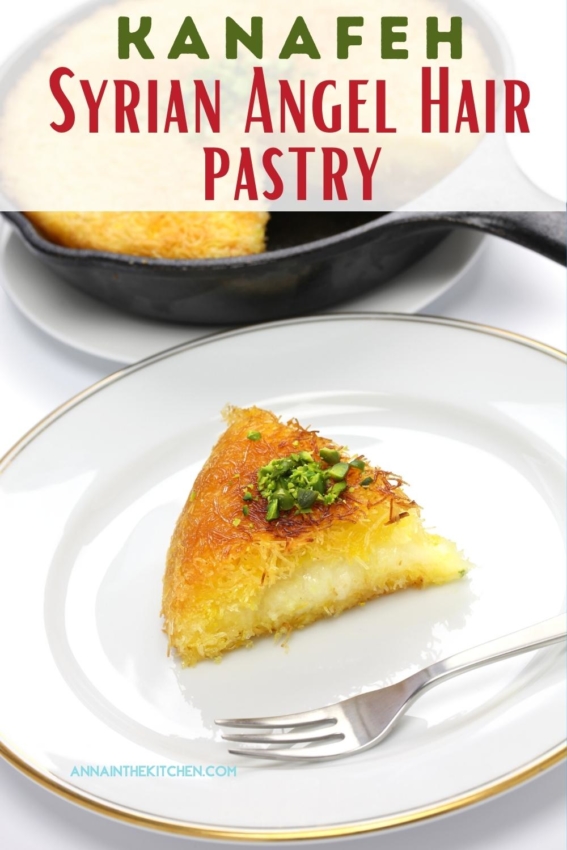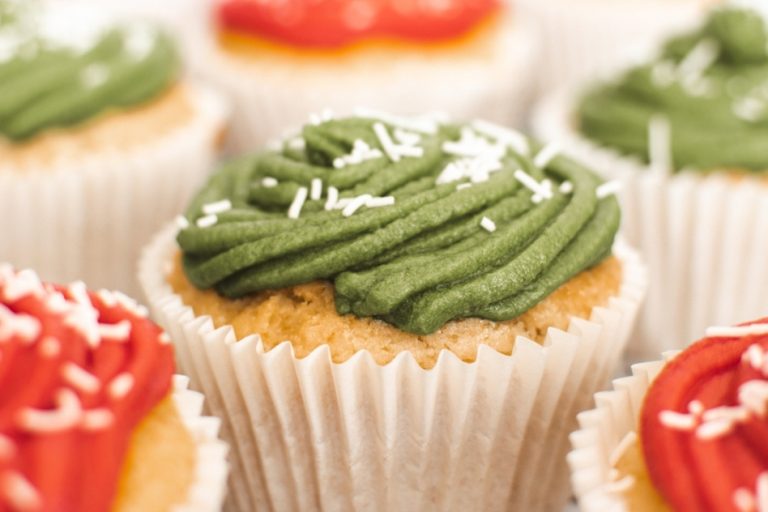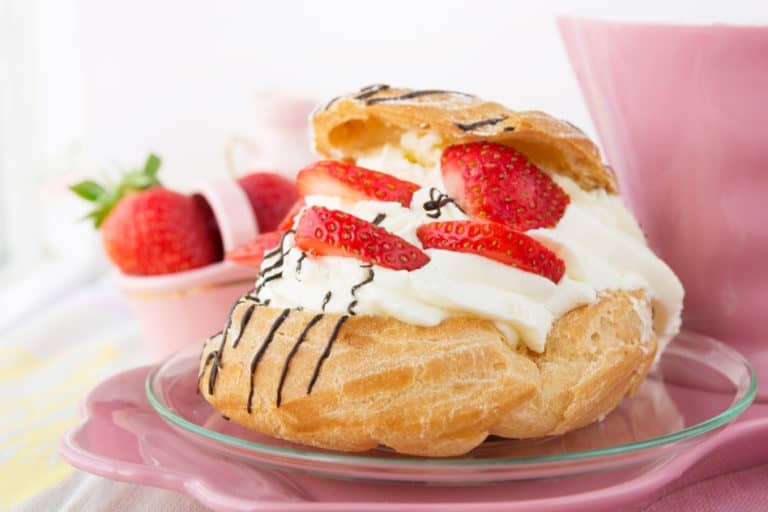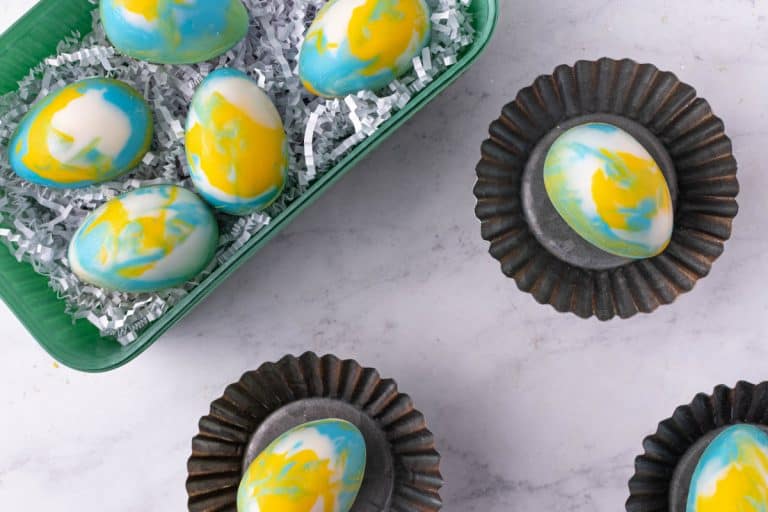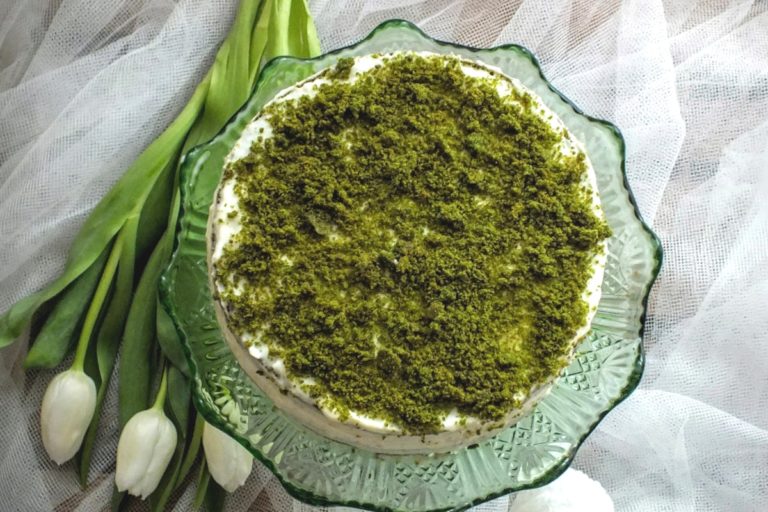Authentic Syrian Kanafeh Recipe
A delicious Middle Eastern dessert of angel hair and clotted cream, the Levantine Kanafeh is the perfect dessert!
What is Kanafeh?
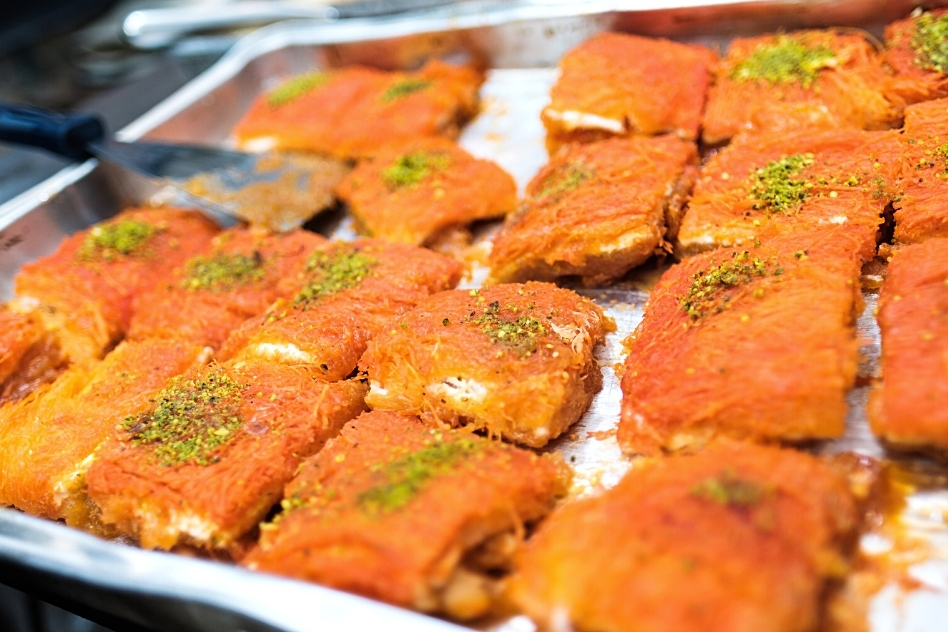
The Syrian Kanafeh or kunafa is a tasty dessert made with crunchy kadaif (angel hair) and creamy akkawi (clotted cream). Two layers of kadaif are filled with a layer of akkawi, sprinkled with nuts, and baked. After baking, the warm kanafeh is topped with a delicious syrup of sugar and rose water.
Kadaif or angel hair is made from wheat flour and sugar with water into a type of phyllo dough and then shredded to resemble fine angel hair. It’s also called kataifi in Greek or Turkish.
Akkawi is a type of cottage cheese that’s named after the port of Akka (Akko or Acre) in Northern Israel. It’s popular in the Middle East and often eaten on its own or rolled in soft flat breads.
Ghee or clarified butter is another important ingredient of kanafeh. You’ll find it used in many Middle Eastern and Indian dishes.
Popular throughout the Levantine region, most countries will have their own version of the kanafeh.
Short History of Kanafeh?
The origins of Kanafeh or knafeh are a matter of dispute, with many Levantine countries claiming origin. But the top runners are Syria and Egypt.
Some legends say that kanafeh was created to alleviate hunger during Ramadan in 10th century Egypt in the Fatimid Caliphate or in Syria in the Umayad Caliphate.
The 10th-century Kitab al-Tabikh or Book of Dishes written by Ibn Sayyar al-Warraq listed many Persian and Arabic recipes from that time. In this book, the kunafa is not listed, but the kataif is.
Later in the 13th century, the Kitab al tabikh fi-l-Maghrib wa-l-Andalus or Book of Dishes from Mahgreb and Al-Andalus lists kunafa as two crepes that are stuffed with a layer of cheese and baked before being topped with nuts, rose water, and honey.
The modern version of the kanafeh was created sometime between then and the 15th century. A 15th-century recipe in the Kitab-al-Tabikh by Muhammad bin Hasan al-Baghdadi has a recipe for kadayif that is actually the modern kanfeh or kunafah.

Different Types of Kanafeh
Depending on which country you’re trying kanafeh in, there are a few different types of kanafeh or kunafah pastry used.
Kunafa Khishneh: The crust of this kanafeh is made from long thin noodle threads.
Kunafa Naameh or Na’ama: This kanafeh is made using a semolina flour called farhahah that’s made into fine pieces of Kunafa dough.
Kunafa Mabroomeh or Mbrwma: This version of kanafeh is made from long thin noodle threads that are rolled around the cheese.
Kunafa Bayn Narain or Mhayara: This is an amazing double decker of kanafeh dough with layers of cheese or cream in the middle.
Different Types of kanafeh in the Middle East
Kanafeh Nabulsieh
Made in a tray, the Kanafeh Nabulsieh originated in the city of Nablus in the West Bank of Palestine/Israel.
This is the most popular version of kanafeh and is made with layers of shredded wheat and white cheese.
Turkish Kunefe or Kadayıf
This Turkish kunefe involves a really soft cheese layered between thin shreds of wiry tel kunefe. After being cooked it’s covered with hot syrup, kaymak which is a clotted cream, and chopped pistachios or walnuts.
Greek Kadaif or καταΐφι
Greek καταΐφι or kataifi is made by rolling tubes of pastries with chopped nuts and cheese. This is quite similar to the baklava, minus the cheese.
Iranian and Azerbaijani Riştə Xətayi
Popular during Ramadan, this version of Kanafeh is found in Tabriz, Iran. In addition to the regular ingredients, it also includes cinnamon, olive oil, and ginger.
Jordanian Kanafa
This version of kanafa is made with a mix of ricotta and mozzarella that makes the kanafa creamy and gooey. Chopped almonds and raisins are covered on top.
Lebanese Knefeh Bi Jibneh
The Lebanese version of the kanafeh is made with semolina and mozzarella that’s drenched in an orange blossom syrup.
This version of kanafeh na’ameh looks more like a cake and is often eaten for breakfast in Lebanon.
Recipe Pointers For Syrian Kanafeh
- Add some orange color or soaked saffron to the angel hair while mixing it with the ghee to give it the traditional color.
- You can also top the kanafeh with dried rose petals.
- If you like, you can replace the chopped pistachios with chopped walnuts or chopped almonds.
- It’s better if the sugar syrup is cold when you drizzle it on the kanafeh.
- You can assemble the kanafeh up to a day before you bake it.
- While mixing the butter or ghee with the dough, make sure it’s mixed in thoroughly. Use your hands if necessary.

FAQs about Syrian Kanafeh
What are the other names of kanafeh?
Kanafeh is also called knafeh, kenafeh, kunafah, kunafeh, konafa, or kunafa.
What does Kunafa mean?
Kunafa is an Arabic word that means flanked, enclosed, or side.
What can I use instead of akkawi?
Feta soaked in water to remove the salt is often used as a replacement for akkawi. You can also use ricotta cheese or mozarella which are quite similar in texture. A 50:50 mix of mozarella and ricotta cheese will also work.
Where can I buy kataifi?
You can buy kataifi in any Middle Eastern, Turkish, or Asian stores.
What can I use instead of kataif?
If you don’t have access to kadaif or kataif, use finely shredded filo pastry.
Do you eat kanafeh hot or cold?
Kanafeh is best eaten hot or warm, but I was actually served a cold version the first time when I visited Syria.
Where was the largest kanafeh made?
Although it didn’t make it to the Guinness Book of World Records, the largest kanafeh was made in Antakya, Turkey in 2017. The kunafa weighed 1550 kgs and was 78 meters long.
How long can I store the kanafeh in the refrigerator?
Kunafeh can be stored for up to a week in the refrigerator. Reheat for 10 to 15 minutes in the oven before serving.
The sugar syrup can also be prepared 2 or 3 days in advance and stored in the refrigerator separately.
Kanafeh: Middle Eastern Angel Hair Dessert

A delicious Middle Eastern dessert of angel hair and clotted cream, the Levantine Kanafeh is the perfect dessert!
Ingredients
Kanafeh
- 8 oz kadaïf angel hair (frozen, can be found at any Middle Eastern supermarket)
- 16 oz akawi cheese (can be replaced with Ricotta)
- 3 oz crushed pistachios
- 5 tablespoons of ghee (can be replaced with butter), melted
- 2 tablespoons of sugar
Syrup
- 3 tablespoons of rose water
- 3 tablespoons of water
- 3 tablespoons of sugar
- 1/2 cup of pistachios, chopped
- squeeze of lemon juice
Instructions
Prepare the syrup
- In a medium saucepan, combine together the sugar, water, rose water and squeeze of lemon juice. Leave to simmer for 5 to 10 minutes until it’s slightly thickened. Set aside.
Prepare the cheese
- Thinly slice both the akawi cheese. If you want to de-salt it a bit, leave it in a decent amount of water overnight changing the water frequently. Drain the cheese by squeezing it with your hands and set aside.
Prepare the dough
- Put the kadaïf in a blender or food processor to reduce its size. Transfer to a big bowl.
- Pour the melted ghee or butter over it and stir thoroughly.
- Transfer half of your kadaïf into a baking dish or tray. Your dish should be filled half-way. Pat it all down with your fingers to make sure the bottom is fully covered.
- Spread akawi cheese on top of your bottom layer. You can mix it with more rose water if you wish. Then cover it all with the rest of your kadaïf.
- Bake for about 25 minutes in 450 F until golden. Sprinkle pistachios on top.
- Serve warm with rose syrup.
Nutrition Information:
Yield:
15Serving Size:
1Amount Per Serving: Calories: 309Total Fat: 23gSaturated Fat: 10gTrans Fat: 0gUnsaturated Fat: 11gCholesterol: 45mgSodium: 283mgCarbohydrates: 17gFiber: 1gSugar: 8gProtein: 11g

